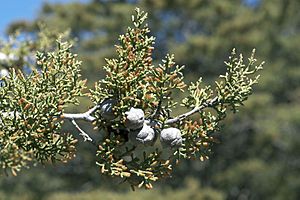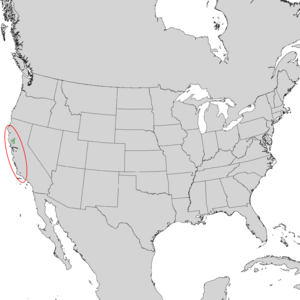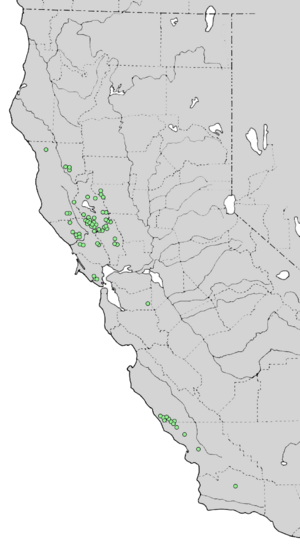Sargent's cypress facts for kids
Quick facts for kids Sargent's cypress |
|
|---|---|
 |
|
| Conservation status | |
| Scientific classification | |
| Genus: |
Cupressus
|
| Species: |
sargentii
|
 |
|
 |
|
| Natural range | |
| Synonyms | |
|
|
The Sargent's cypress (Cupressus sargentii) is a special type of tree. It belongs to the conifer family, which includes trees like pines and firs. This tree is found only in California, USA. It grows in the Coast Range mountains, from Mendocino County down to Santa Barbara County.
Sargent's cypress often grows in groups on its own. It likes a specific type of ground called serpentine soil. This soil has high mineral levels.
Sargent's Cypress: Where It Lives
Sargent's cypress trees are native to California. This means they naturally grow there and nowhere else in the world. They are found along the Coast Range mountains. These trees like to grow in forests with other cone-bearing trees. They also live in areas with chaparral, which is a type of shrubland.
Special Soils and Small Trees
These cypress trees usually grow best in serpentine soil. This soil is rich in certain minerals. It can be a tough place for many plants to grow. Sargent's cypress has adapted to these unique conditions.
Most Sargent's cypress trees grow about 10 to 15 meters (33–50 feet) tall. Some can even reach over 22 meters (73 feet). But in some places, like Carson Ridge in Marin County, they are much smaller. Here, they form a "pygmy forest." The trees are only 240–360 centimeters (8–12 feet) tall. This happens because of the very high mineral levels in the serpentine soil.
Life Cycle: How Sargent's Cypress Reproduces
Like many cypress trees in the Americas, Sargent's cypress often needs wildfire to reproduce. The heat from a fire makes their cones open up. This releases their seeds. The fire also clears the ground, making it ready for new seedlings to grow.
Sometimes, seeds can fall and grow without a fire. But this is not very common. It's more likely that a fire will help them spread. Because of this, you might find many trees in one area that are all the same age. This shows that they likely grew after the same fire. Sargent's cypress trees can start making cones and seeds when they are only five or six years old.


